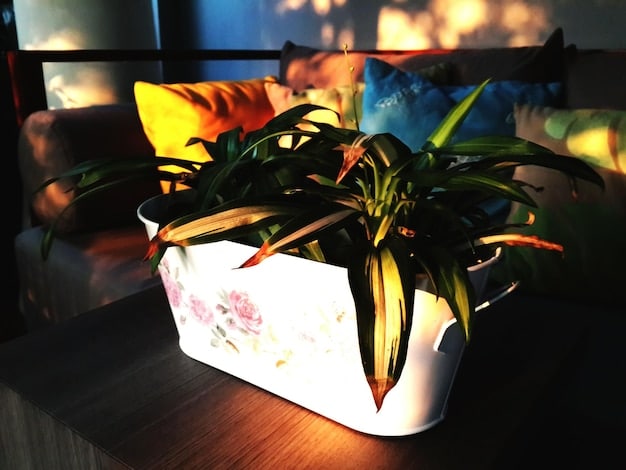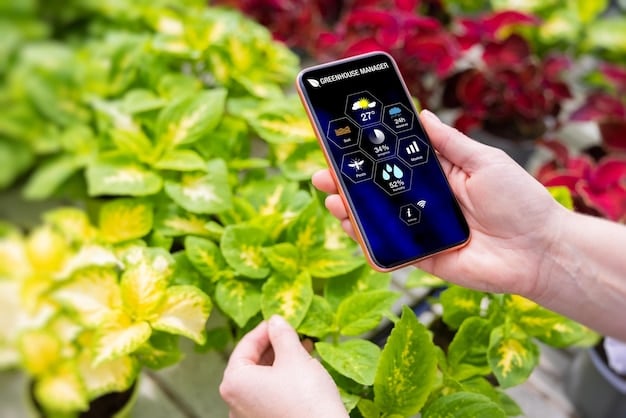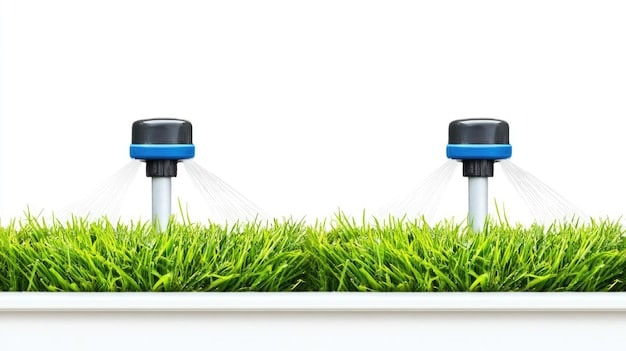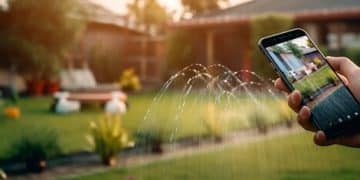Smart Home Gardening: Automate Watering and Grow Healthier Plants

Smart home gardening involves automating your watering system to optimize plant health, conserve water, and manage your garden remotely, leading to more efficient and thriving plant growth.
Imagine effortlessly maintaining a lush garden, even with a busy schedule. Smart home gardening makes this a reality by automating your watering system, ensuring your plants receive the precise amount of hydration they need, promoting healthier growth and saving you time and resources.
Why Automate Your Watering System?
Automating your watering system offers numerous advantages for both your plants and your lifestyle. Gone are the days of guessing when and how much to water. Embrace a smarter, more efficient approach to gardening.
Let’s explore why this technology is becoming increasingly popular among gardening enthusiasts.
Benefits of Automated Watering
Automating your watering system takes the guesswork out of gardening, ensuring your plants receive consistent and optimal hydration.
Time and Water Savings
Automated systems are designed to conserve water and save you valuable time. Precise watering schedules eliminate overwatering and underwatering, promoting efficient water use.
- Consistent Hydration: Ensures plants receive the right amount of water, promoting healthier growth.
- Water Conservation: Reduces water waste by delivering water directly to the roots.
- Time Efficiency: Frees up your time, eliminating the need for manual watering.
- Remote Management: Allows you to control your watering system from anywhere using your smartphone.
By automating your watering, you not only save time and water but also provide a more stable and nurturing environment for your plants. This leads to healthier, more vibrant gardens that thrive with minimal effort.

Essential Components for a Smart Watering System
Creating an efficient smart watering system involves several key components that work together to automate and optimize your gardening efforts. Understanding these components is crucial for setting up a system that meets your specific needs.
Each component plays a vital role in ensuring your plants receive the right amount of water at the right time.
Smart Irrigation Controllers
Smart irrigation controllers are the brains of the system, allowing you to set watering schedules and monitor moisture levels.
Moisture Sensors
Moisture sensors measure the moisture content in the soil, providing real-time data to the controller, ensuring water is only delivered when needed.
- Smart Controllers: Program watering schedules based on weather data and plant needs.
- Moisture Sensors: Measure soil moisture levels to prevent overwatering.
- Smart Valves: Control the flow of water to different zones in your garden.
- Mobile Apps: Provide remote access and control of your watering system.
These components, when combined, create a powerful and efficient system that ensures your garden remains healthy and vibrant. They offer the flexibility and control needed to manage your garden effectively, regardless of your location.
Setting Up Your Smart Watering System
Setting up a smart watering system involves several steps, from planning and purchasing components to installation and configuration. A well-planned setup ensures your system operates efficiently and effectively.
Let’s walk through the process to help you create a smart garden tailored to your needs.
Planning and Design
Start by assessing your garden’s needs, including plant types, soil conditions, and sunlight exposure. This will help you determine the type of system and components you need.
Installation and Configuration
Proper installation is crucial for the system’s performance. Follow the manufacturer’s instructions carefully and ensure all components are correctly connected.
- Assess Garden Needs: Evaluate plant types, soil conditions, and sunlight exposure.
- Choose Components: Select the right controllers, sensors, and valves for your garden.
- Install the System: Follow manufacturer instructions for proper installation.
- Configure Settings: Set watering schedules and monitor moisture levels.
With a well-planned and properly installed system, you can enjoy the benefits of automated watering, knowing your garden is receiving the precise care it needs to thrive. This setup ensures a healthy and vibrant garden with minimal manual intervention.
Choosing the Right Smart Watering Technology
The market offers a variety of smart watering technologies, each with its unique features and capabilities. Selecting the right technology depends on your specific gardening needs and preferences.
Understanding the different options available will help you make an informed decision.

Drip Irrigation Systems
Drip irrigation systems deliver water directly to the roots, minimizing water waste and promoting healthy plant growth.
Sprinkler Systems
Sprinkler systems provide broader coverage, making them suitable for larger areas and lawns.
Consider researching these points before purchasing your Smart Watering System:
- Drip vs. Sprinkler: Choose the system that best suits your plant types and garden layout.
- Brand Reputation: Research reputable brands known for quality and reliability.
- Compatibility: Ensure components are compatible with your existing smart home ecosystem.
- User Reviews: Read reviews from other gardeners to gauge performance and ease of use.
By carefully considering these factors, you can choose a smart watering technology that meets your needs and helps you achieve a thriving and efficient garden. This ensures that your plants receive the optimal care they need to flourish.
Troubleshooting Common Issues
Even with the best planning and installation, you might encounter occasional issues with your smart watering system. Knowing how to troubleshoot common problems can save you time and frustration.
Let’s address some common issues and their solutions.
Sensor Malfunctions
Moisture sensors can sometimes malfunction due to dirt, damage, or battery issues. Regular maintenance and replacement of batteries can prevent these problems.
Controller Connectivity Problems
Connectivity issues may arise due to weak Wi-Fi signals or software glitches. Ensure your controller has a strong Wi-Fi connection and update the software regularly.
- Sensor Maintenance: Clean sensors regularly and replace batteries as needed.
- Connectivity Checks: Ensure a strong Wi-Fi signal and update controller software.
- Valve Inspections: Check valves for leaks and clogs.
- Schedule Reviews: Review watering schedules periodically to ensure accuracy.
By addressing these common issues promptly, you can keep your smart watering system running smoothly and ensure your garden receives the optimal care it needs. Regular maintenance and troubleshooting will help you avoid major problems and maintain a thriving garden.
Advanced Features and Integrations
Smart watering systems offer advanced features and integrations that can further enhance your gardening experience. These features provide more control and automation, allowing you to optimize your garden’s health and efficiency.
Explore some advanced capabilities that can take your smart garden to the next level.
Weather Integration
Many smart controllers integrate with weather forecasts, adjusting watering schedules based on predicted rain or temperature changes. This ensures your plants receive the right amount of water, regardless of weather conditions.
Voice Control and Smart Home Integration
Some systems offer voice control via smart home devices like Amazon Echo or Google Home. This allows you to manage your watering system hands-free and integrate it with other smart home devices.
- Weather Monitoring: Adjust watering schedules based on real-time weather data.
- Voice Control: Manage your system hands-free with voice commands.
- Smart Home Integration: Integrate with other smart home devices for seamless control.
- Custom Zones: Create custom watering zones based on plant types and soil conditions.
These advanced features and integrations provide greater flexibility and control over your smart watering system, allowing you to create a truly automated and efficient garden. They ensure your plants receive optimal care while saving you time and resources.
| Key Point | Brief Description |
|---|---|
| 💧 Water Conservation | Smart systems use water efficiently, reducing waste. |
| 🌱 Healthier Plants | Consistent hydration promotes optimal growth. |
| ⏱️ Time Savings | Automation frees up time for other gardening tasks. |
| 📱 Remote Control | Manage your garden from anywhere with a smartphone. |
Frequently Asked Questions (FAQ)
▼
Smart watering systems use sensors and weather data to deliver water only when needed, reducing overwatering and water waste. They also use targeted methods like drip irrigation.
▼
Yes, most smart watering systems come with mobile apps that allow you to control and monitor your system from anywhere using your smartphone or tablet.
▼
All types of plants can benefit, but it’s especially useful for plants with specific watering needs, such as those in containers or plants that require consistent moisture levels.
▼
Consider factors like soil type, plant needs, and the sensor’s compatibility with your smart controller. Look for sensors that provide accurate and reliable readings.
▼
Regular maintenance includes cleaning sensors, checking for leaks, updating software, and ensuring a strong Wi-Fi connection. Replace batteries as needed to keep the system running smoothly.
Conclusion
Embracing smart home gardening by automating your watering system can transform your gardening experience, offering healthier plants, water conservation, and time savings. By understanding the essential components, setup process, and advanced features, you can create a thriving and efficient garden with minimal effort. So, take the leap and enjoy the benefits of a smarter, greener garden today.





